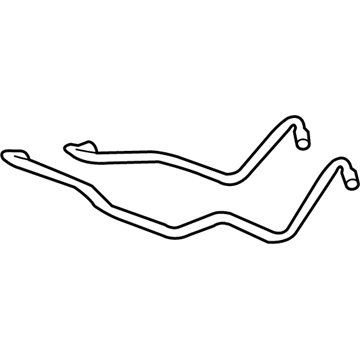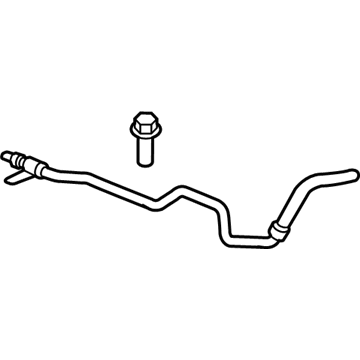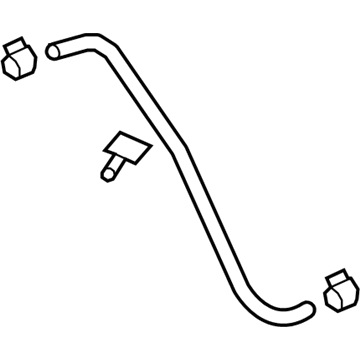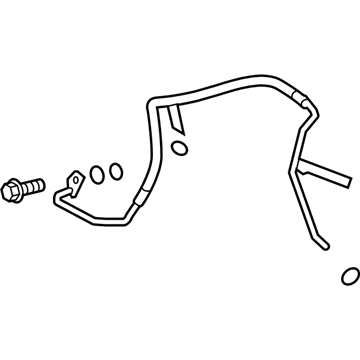ChevyParts
My Garage
My Account
Cart
OEM 2010 Chevrolet Traverse Power Steering Hose
Power Steering Pressure Hose- Select Vehicle by Model
- Select Vehicle by VIN
Select Vehicle by Model
orMake
Model
Year
Select Vehicle by VIN
For the most accurate results, select vehicle by your VIN (Vehicle Identification Number).
6 Power Steering Hoses found
2010 Chevrolet Traverse Power Steering Return Hose Part Number: 22915139
$61.69 MSRP: $105.05You Save: $43.36 (42%)Ships in 1-2 Business DaysProduct Specifications- Other Name: Hose Assembly-Power Steering Gear Outlet; Power Steering Hose; Lower Return Line; Hose, Steering Gear Oil Return
- Replaced by: 19436425
- Item Weight: 1.00 Pounds
- Item Dimensions: 34.5 x 13.8 x 9.6 inches
- Condition: New
- Fitment Type: Direct Replacement
- SKU: 22915139
- Warranty: This genuine part is guaranteed by GM's factory warranty.
2010 Chevrolet Traverse Pipe Kit Part Number: 20887540
$45.73 MSRP: $77.64You Save: $31.91 (42%)Ships in 1-2 Business DaysProduct Specifications- Other Name: Pipe Kit, Steering Gear Oil Pressure; Power Steering Hose; Pipe Kit, Hydraulic Steering Gear Pressure
- Replaces: 15948976
- Item Weight: 0.40 Pounds
- Item Dimensions: 22.4 x 6.0 x 5.9 inches
- Condition: New
- Fitment Type: Direct Replacement
- SKU: 20887540
- Warranty: This genuine part is guaranteed by GM's factory warranty.
2010 Chevrolet Traverse Return Hose Part Number: 22915138
$40.21 MSRP: $66.25You Save: $26.04 (40%)Ships in 1-2 Business DaysProduct Specifications- Other Name: Pipe, Steering Fluid Cooler; Power Steering Hose; Lower Return Tube
- Replaces: 15869853, 25876164, 25840979
- Item Weight: 0.80 Pounds
- Item Dimensions: 25.4 x 7.1 x 5.6 inches
- Condition: New
- Fitment Type: Direct Replacement
- SKU: 22915138
- Warranty: This genuine part is guaranteed by GM's factory warranty.
2010 Chevrolet Traverse Power Steering Pressure Hose Part Number: 22913984
$29.72 MSRP: $48.98You Save: $19.26 (40%)Ships in 1-2 Business DaysProduct Specifications- Other Name: Hose-Power Steering Fluid Reservoir Outlet; Power Steering Hose; Suction Hose; Hose, Hydraulic Steering Gear Pressure; Hose, Steering Gear Oil Pressure; Hose, Steering Gear Oil Return
- Replaces: 20928145, 22789060, 25879973
- Item Weight: 1.00 Pounds
- Item Dimensions: 23.1 x 10.5 x 4.1 inches
- Condition: New
- Fitment Type: Direct Replacement
- SKU: 22913984
- Warranty: This genuine part is guaranteed by GM's factory warranty.
2010 Chevrolet Traverse Power Steering Return Hose Part Number: 22847737
$17.16 MSRP: $28.27You Save: $11.11 (40%)Ships in 1-2 Business DaysProduct Specifications- Other Name: Hose Assembly-Power Steering Fluid Reservoir Inlet; Power Steering Hose; Reservoir Hose; Hose, Steering Gear Oil Return
- Replaces: 22780186, 20767191, 25925955
- Item Weight: 0.70 Pounds
- Item Dimensions: 3.4 x 22.2 x 3.0 inches
- Condition: New
- Fitment Type: Direct Replacement
- SKU: 22847737
- Warranty: This genuine part is guaranteed by GM's factory warranty.
2010 Chevrolet Traverse Power Steering Pressure Hose Part Number: 19433875
$162.66 MSRP: $276.93You Save: $114.27 (42%)Product Specifications- Other Name: Hose, Steering Gear Oil Pressure; Pressure Hose; Hose, Hydraulic Steering Gear Pressure
- Replaced by: 19540418
- Replaces: 20938551, 22912855, 25805111, 15923722, 20920116, 22802435, 20779364
- Condition: New
- SKU: 19433875
- Warranty: This genuine part is guaranteed by GM's factory warranty.
2010 Chevrolet Traverse Power Steering Hose
With a comprehensive array of OEM 2010 Chevrolet Traverse Power Steering Hose, from fuel pumps to door handles, our website is a one-stop-shop for your needs. All our genuine 2010 Chevrolet Traverse Power Steering Hose are backed by the manufacturer's warranty and are offered at competitive prices in the market. Rest assured, you can shop with complete confidence.
2010 Chevrolet Traverse Power Steering Hose Parts Questions & Experts Answers
- Q: How to replace the Power Steering Hose on 2010 Chevrolet Traverse?A: The replacement of Power Steering Cooler pipe/hose requires initial removal of the right front frontwards wheelhouse liner. Install drain pans beneath the vehicle as necessary for preventions of fluid leakage. Detach the Power Steering Cooler pipe through release of its clamp while removing the pipe from the power steering fluid cooler . The power steering gear outlet hose bracket bolt requires removal while the power steering gear outlet hose clamp goes into disposal. Detach the Power Steering Cooler pipe from the power steering gear outlet hose (4, 3) then remove all plastic clips on the Power Steering Cooler pipe before discarding them. The Power Steering Cooler pipe needs to be taken off from the vehicle. The process starts with installing the new Power Steering Cooler pipe before adding a new Power Steering Cooler pipe clamp. Tighten the power steering gear outlet hose bracket bolt to 8 nm (71 lb in) while performing the connection of the Power Steering Cooler pipe to the power steering gear outlet hose (4, 3). Duplicate the Power Steering Cooler pipe by connecting it to the power steering fluid cooler while tigthening the Power Steering Cooler pipe clamp. After cleaning excess fluid from the vehicle the right front frontwards wheelhouse liner should be reinstalled. The procedure for power steering system filling and bleeding needs to be completed last.



















